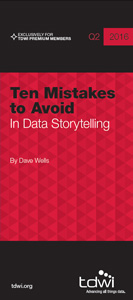
Ten Mistakes to Avoid in Data Storytelling
TDWI Member Exclusive
May 5, 2016
By Dave Wells
All too frequently, analytics activity ends with producing
and publishing data visualizations—charts and graphs that
illustrate findings from data but fail to interpret those findings, communicate insight, or inspire action. Although data visualization is valuable, the viewers of data visuals are left to draw their own conclusions that may be incorrect, out of context, or inconsistent.
Data storytelling takes the next step beyond data visualization by connecting multiple visuals with narrative, offering interpretation, and inviting conversation. Data storytelling is not just a way to share analytical insights. It is also a highly effective way to validate and refine insights. Data storytelling is the new horizon of business analytics.
Stories are powerful. We’ve used them throughout history to
capture attention, convey ideas, fire the imagination, and stir the soul. Stories are memorable. They “stick”—being told and retold, creating continuity, and shaping cultures. Data can be persuasive but stories are compelling. Blending data and stories—data storytelling—is a particularly powerful combination.
Data storytellers are the next generation of business and data analysts. Data storytelling is a recent and important contribution to analytics, going beyond quantification and visualization to complement data with narrative. A well-told story that is interesting and convincing may appear quite easy on the surface, but crafting a good data story is challenging. Becoming a skilled storyteller, however, is not easy and may be particularly challenging for those who are naturally inclined to the disciplines of structure, statistics, and sciences. Avoid these 10 mistakes to advance your storytelling skills and increase the impact of your data stories.